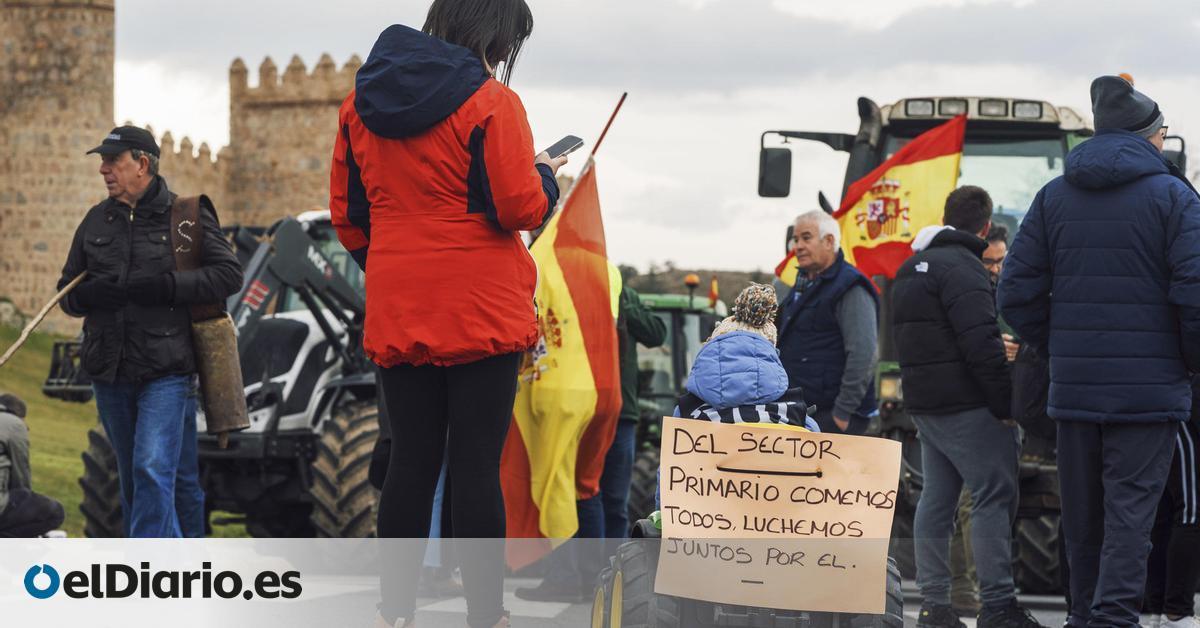
The x-ray of the primary sector in Spain confirms a complex situation marked by the stagnation of activity and, above all, the decline of small and medium-sized farmers, ranchers or fishermen. Rising costs and droughts have aggravated the difficulties in general and, specifically, the crisis of the traditional model, which was made up mostly of self-employed workers, favoring the business of large companies in all links of the food chain.
“You don’t know the look on your face, after spending all day pruning with wind and rain, when you go on social media and see 200 enlightened people saying that I’m not a farm worker, that I’m the bosses,” he laments. a young farmer from Alcarria. Its family business model is the one that has suffered the most in recent years, and the one that supports all the demands that spread across Europe and our country: the escalation of costs (of machinery, fertilizers, phytosanitary…), poor harvests and regulatory inequality vis-à-vis non-EU producers (from Ukraine, Morocco or Turkey, among others).
The data reflect that surviving in the primary sector in Spain without being a ‘giant’ is increasingly difficult, despite European subsidies and anti-crisis aid from the Government. The number of self-employed people and their sales have been reduced, the crops are increasingly larger and are in fewer hands and close to 10% of agricultural holdings have disappeared in the last 15 years (up to 37% in the Union as a whole European).
On the other hand, and precisely as a result of this context, the profit margins of large companies have increased in the inflation crisis. Furthermore, these types of companies do grow in number. “In the end, industries and distribution push for increasingly larger and more controllable farms,” explained Diego Juste, spokesperson for UPA (Union of Small Farmers and Ranchers) to elDiario.es. This farmer also pointed to other factors, such as the progressive “mechanization”, which means that the level of expenditure is sometimes not affordable for small farms, and also the “progressive depopulation” of rural territory.
The starting point: stagnation of ‘agricultural GDP’
To carry out an x-ray of the primary sector in Spain, a starting point can be to observe the evolution of Agricultural Income (colloquially known as ‘agricultural GDP’) calculated by the Ministry of Agriculture, Fisheries and Food. This indicator includes “the income generated in agriculture, livestock and hunting activities” and shows stagnation at 2016 levels despite the recovery last year, led by the major players in the sector and livestock farming.
In the details of the 2023 Agricultural Income, an increase in some costs is observed – seeds and seedlings, maintenance of material and properties and services. Likewise, a reduction in the cost of energy (-32.2%) and fertilizers (-13.6) is recorded, mainly because in 2022 they skyrocketed due to the Russian invasion of Ukraine.
Regarding sales prices, almost all of them increased last year – with the very notable rise in oil -, although the value of production behaved very unevenly as profit margins contracted (this happens if costs rise more than sales) or decrease quantities: with significant drops of 50% in the case of cereals, 30% in oil or 20% in wine, and with generalized growth in livestock.
More large companies, which do improve their margins
So far, the aggregate data, from the entire agriculture, livestock and hunting sector. If you change the source of information, and go to the Business Margins Observatory, new conclusions are obtained. This statistic was created by the Ministry of Economy, the Bank of Spain and the Tax Agency in this inflation crisis to have more information on the distribution of the damage of price increases between companies and workers, and to detect which sectors have taken advantage or They are taking advantage to obtain more profits by transferring the increase in costs to the sales prices
In this case, the primary sector data brings together agriculture, livestock, forestry and fishing. On the other hand, according to the Observatory itself, “it should be noted that the sector is poorly represented in the statistical sample, given that it does not include data on self-employed workers, with a high presence in the sector.” That is, the information obtained is from companies that have not stopped growing in number in recent years and that have increased their profit margins according to the different approaches carried out by the Observatory (the most basic one is shown in the previous graph). : sales minus purchases, but the trend is the same if you look at other calculations).
Fewer farmers
To find the weak part of the sector, you have to consult the Personal Income Tax statistics from the Tax Agency. The data in the following graph compiles the net income (after deducting expenses) of the agricultural self-employed, and the total number, until 2021. This figure is close to 900,000 people, which is much more than active farmers according to the EPA (Survey of Active Population) because there are many people who have land but do not live (in terms of main occupation) from agriculture.
The evolution is downward, and the profits they obtain also fall, in contrast to what happens with the large companies that are represented in the Margins Observatory. Even if you look at the distinction that the Tax Agency makes between normal self-employed people and ‘rich’ self-employed people, with high incomes, the picture is much worse for the former. It is evidence of the crisis of the traditional model.
Change of model in Spain: increasingly larger crops and in fewer hands
In the last decade, the area in Spain destined for agricultural use is practically the same. Nearly 24 million hectares in which all types of crops are produced: fruit trees, vineyards, olive groves, pastures… The variation in ten years has been minimal, less than 1%. What has changed is the number of farms: there are almost 8% fewer than in 2009. The combination of these two factors indicates that agricultural production is increasingly concentrated.
It is one of the conclusions drawn by the data from the latest Agrarian Census (2020) published by the National Institute of Statistics (INE) in 2022. It is an exhaustive statistical operation that has not been carried out for ten years, and whose first publication It was in 1999.
In 1999, 54% of agricultural land was on farms of more than 100 hectares, this proportion increased to 55% ten years later and, in 2020, macro crops already accounted for 58% of all agricultural land in Spain. . The rest of the farms of other sizes have been losing ground while the largest ones grew more and more.
The Spanish countryside loses weight in the EU
If the focus is broadened and a comparison of the Spanish primary sector is sought with that of the other large European economies (Germany, Italy and France), a special incidence of common problems in our country is observed.
The total production of agriculture, livestock and fishing in Spain, measured according to the Gross Added Value (GVA) of the National Accounting, reached 27%, in 2016, of the sum of the four main EU countries, such as It is seen in the last graph of this information. Now, it has dropped to 21%.
Meanwhile, the production of Spain’s primary sector with respect to the country’s total GVA (the production of all industries) has fallen from 3.2% to 2.5%, a minimum of 2009.
Source: www.eldiario.es

